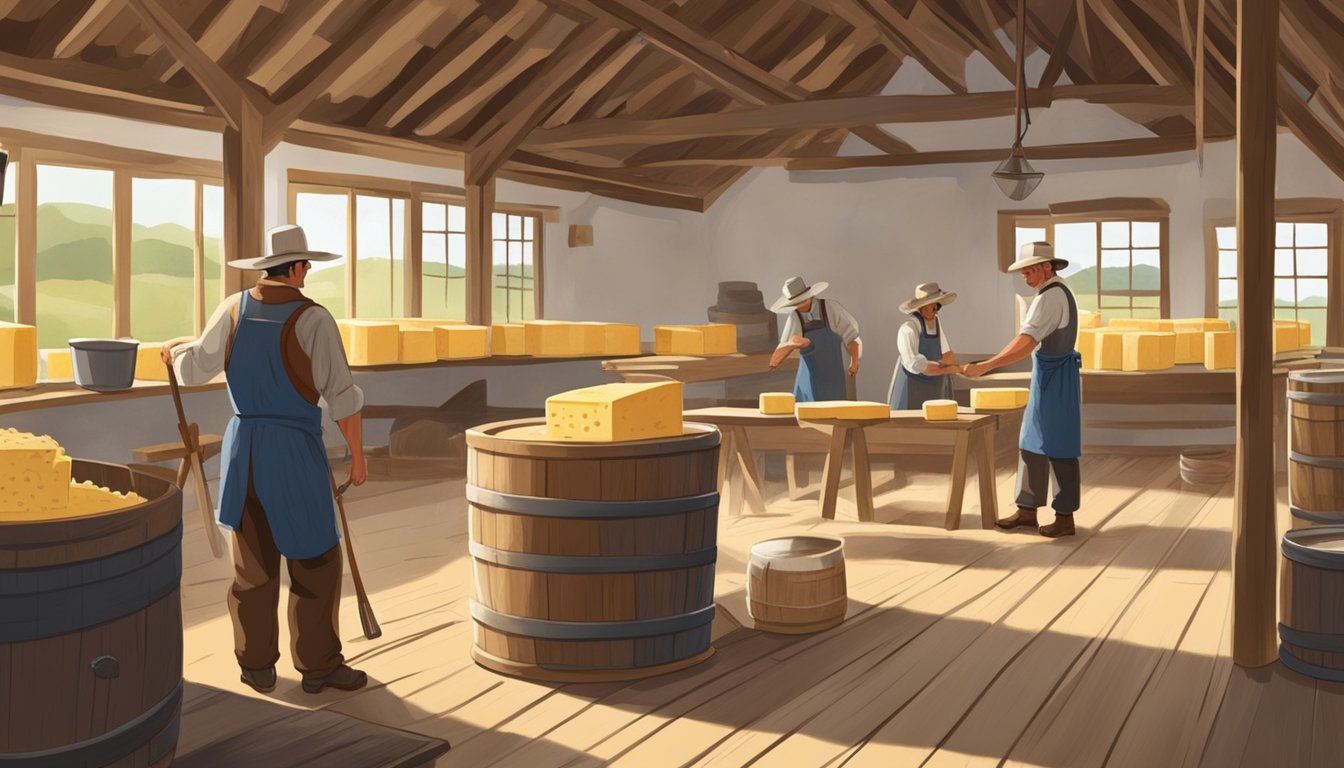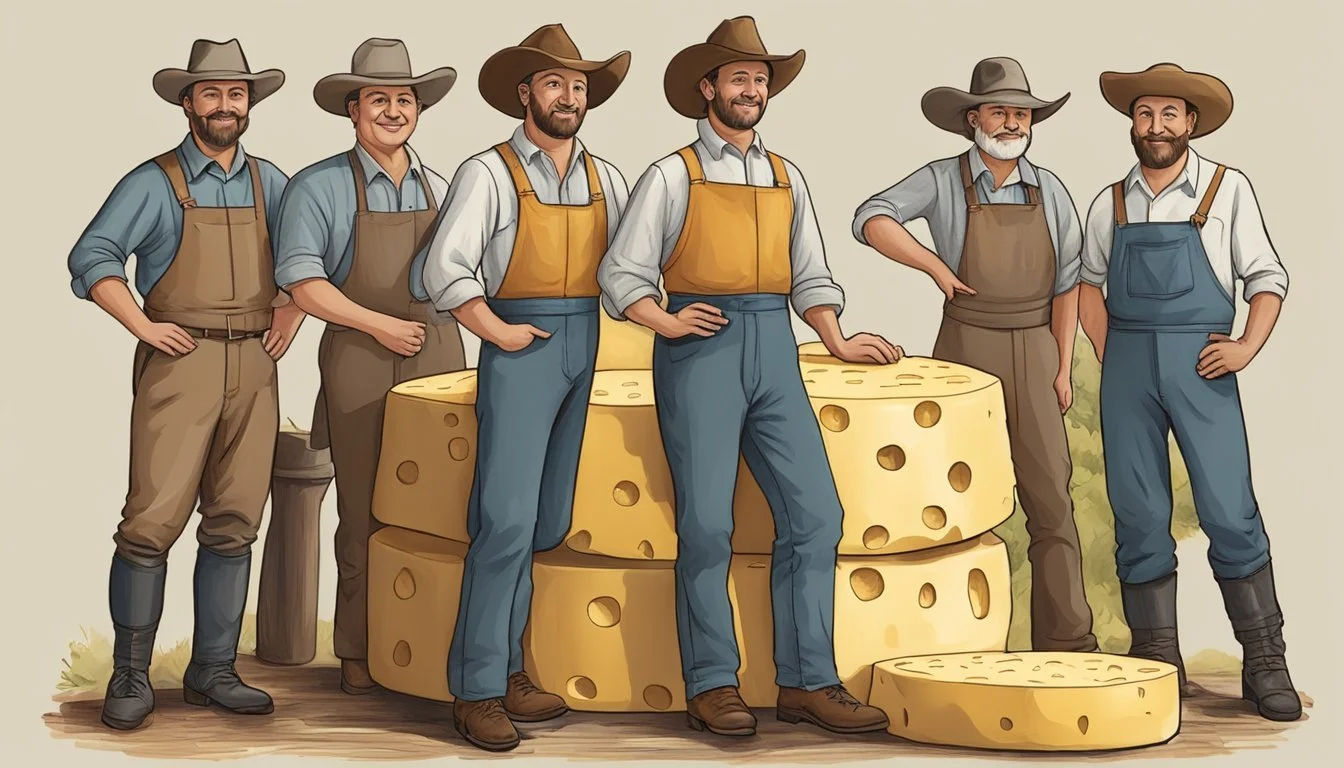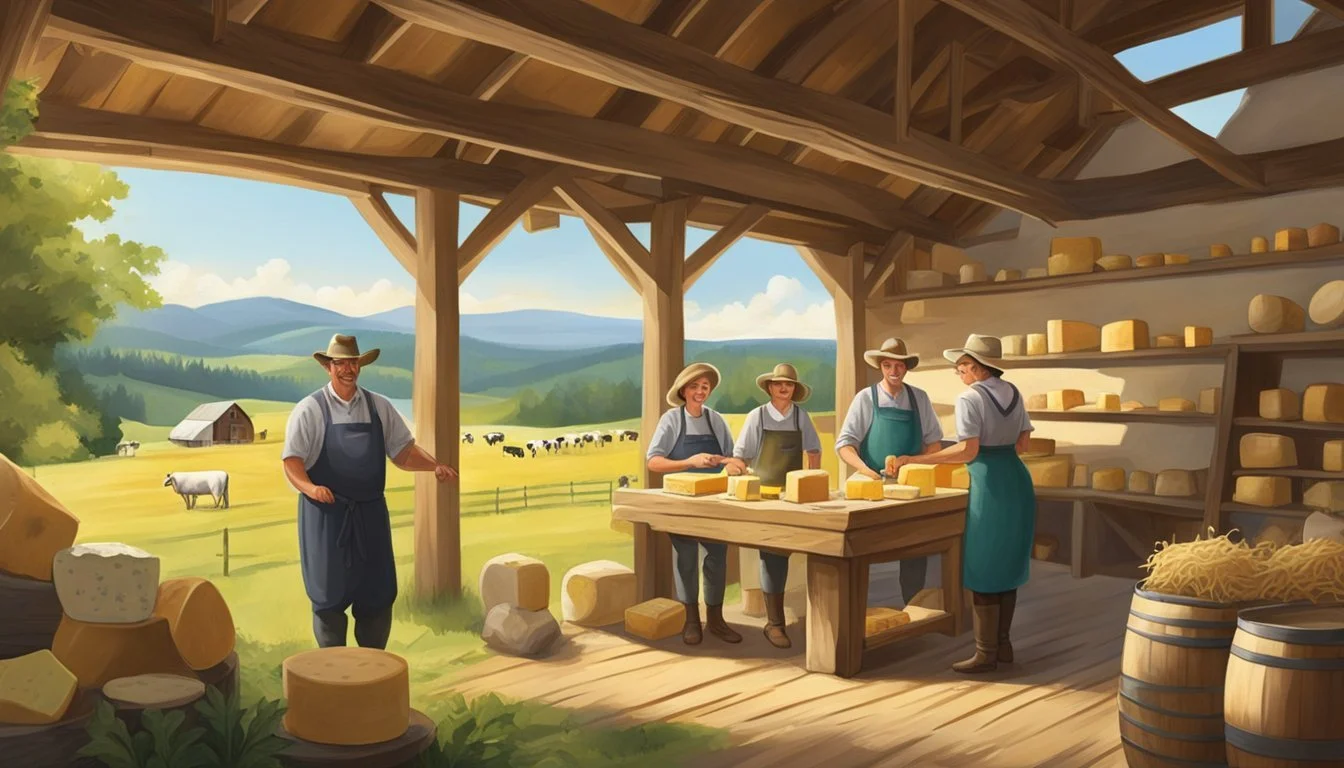German Texan Contributions to Texas Cheesemaking
A Historical Perspective
The influence of German immigrants on Texas has been both deep and enduring, especially in the realm of cheesemaking. German Texans, capitalizing on their dairy farming heritage, brought traditional cheesemaking methods with them in the 19th century, creating a foundation for a thriving industry. These settlers brought with them a rich knowledge of dairy production, and the Texas landscape provided a new but accommodating environment for the practice of their Old World craftsmanship. With an environment conducive to livestock farming, they were well-placed to nurture the growth of Texas's fledgling dairy industry.
Their cheesemaking techniques, adapted from the practices of their homeland, have had a significant impact on the local cuisine and agricultural practices. For instance, they introduced a variety of European cheese (What wine goes well with cheese?) styles that were previously unfamiliar in the region. This blend of German artisanal skills and Texan raw materials gave rise to unique varieties of cheese which are still produced and celebrated in the state today.
Besides contributing to the state's economic and gastronomic tapestry, this legacy of German Texans has also helped in preserving the cultural identity of the state's German community. Whether through family-owned creameries or larger-scale operations, the influence of German heritage continues to be a vital part of the story of Texas cheesemaking, adding to the state's rich cultural mosaic.
Historical Context of German Immigration to Texas
The influx of German immigrants during the 19th century greatly influenced the population and culture of Central Texas. Their migration patterns and the role of the Adelsverein were pivotal to their settlement and integration into Texan society.
Early Migration and Settlement Patterns
German settlers began to arrive in Texas during the early 19th century, drawn by the promise of land and prosperity. Friedrich Ernst, often called the "Father of German Immigration to Texas," was one such settler who arrived in the 1830s and encouraged others from his native Germany to join him. These early migrants initially settled in Central Texas, forming tight-knit communities that retained many of their European roots in customs and lifestyle.
The early migration saw a mixture of farmers, artisans, and intellectuals leaving Germany, driven by political strife and economic challenges in their homeland. They established German-speaking enclaves, which later facilitated larger waves of migrants who looked to Texas as a haven from the tumultuous political climate in Europe. Their settlement patterns were characterized by clustered villages, which allowed them to maintain their cultural identity while adapting to their new environment.
The German population in Texas grew significantly by the mid-19th century, with about 150,000 Germans comprising over five percent of the Texas population by 1900. This growth not only increased the state's cultural diversity but also contributed to the economic development of the region. German Texans demonstrated a capacity for dealing with the challenges posed by the frontier, including relations with Native American tribes such as the Comanche.
The Role of Adelsverein in German Texan History
The Adelsverein, formally known as the Society for the Protection of German Immigrants in Texas, was established in 1842 with the aim of organizing and supporting the migration and settlement of Germans in Texas. The Mainzer Adelsverein played a critical role in shaping the course of German Texan history by buying land and establishing colonies where German settlers could begin their new lives.
Between 1844 and 1847, the Adelsverein facilitated the journey of more than 7,000 Germans to Texas. Despite facing hardships such as epidemics and limited resources, many immigrants overcame these challenges to build thriving communities, such as New Braunfels and Fredericksburg in the Texas Hill Country. These towns would later become the western end of what was known as the German Belt.
The organization's efforts continued past the Civil War and into the late 19th century, although the focus shifted toward supporting the existing German Texan communities rather than organizing new migrations. The period following the Civil War up to World War I saw the German Texans emerging as a significant cultural and economic force, contributing to various industries, including agriculture and, notably, cheesemaking in the region.
Cultural Contributions and Integration
German immigrants to Texas brought with them a wealth of traditions and skills that have been well integrated into the Texan tapestry, particularly in the realms of food, architecture, cultural celebrations, and language.
German Influence on Texan Cuisine
German settlers in Texas have had a profound impact on the state's food scene. Fredericksburg and New Braunfels are at the heart of this culinary integration. German techniques and flavors, seen in the popularity of sausages and Texas barbecue, have merged with local ingredients to create unique Texan dishes. The annual Wurstfest celebrates this melding of cuisines, showcasing a variety of sausages, breads, and wine, all staples of German fare.
Architectural Impact and Preservation
German influences in Texan architecture are evident in towns like Fredericksburg and the King William district of San Antonio. Fachwerk, a traditional German timber-framing construction method, prevails in these areas. Many of these structures have been preserved, continuing to serve as homes, shops, and cultural landmarks. The German culture has thus left an indelible architectural footprint that's celebrated and maintained to this day.
Traditions, Festivals, and Celebrations
Germans in Texas zealously celebrate their heritage through various events, including Oktoberfest in Fredericksburg, Saengerfest, and the more localized German Culture Month. These festivals are not only about revelry; they serve to preserve and educate attendees about German customs, from folk dances to traditional costumes, and foster a sense of community.
Language and Print Culture
Even with the anglicization of many immigrant populations, the German language and print culture retain a foothold in Texas. Newspapers like the New Braunfels Herald-Zeitung reflect a continued use of German in media. Churches and schools often weave German phrases and decor into services and teachings, bridging past and present Germanic influences within daily Texan life.
Socioeconomic Impact
The introduction of cheesemaking by German Texans has had a marked impact on the state's agriculture, industry, and urban demographic landscape. They were instrumental in developing the necessary agricultural practices and fostering economic growth through this niche industry.
Agricultural Development and Livestock Rearing
German immigrants brought with them advanced European agricultural techniques, greatly influencing the Texan agricultural sector, particularly in San Antonio and Austin. They integrated their knowledge of livestock rearing, which was essential for producing milk—a key ingredient in cheesemaking. Livestock breeding practices improved under their influence, impacting the variety and quality of cheese produced in Texas.
Industry and Economic Growth
As the cheesemaking industry grew, it catalyzed economic growth within Texas. The establishment of cheese-related businesses created jobs and contributed to the local and state economies. The industry's growth prompted further investment in transportation and communications to support the distribution of Texas cheese both within the state, including to Houston, and beyond its borders.
Urban Contributions and Demographic Shift
The influx of German settlers in areas such as New Braunfels and Fredericksburg led to urban contributions that shaped the cultural and economic fabric of these towns. Their expertise in cheesemaking and related commerce spurred a demographic shift, as people moved to cities looking for new opportunities in these growing industries. This migration has not only fortified the urban economies but also diversified the demographic profile of Texas cities.
Notable German Texan Figures and Legacies
German Texans have left a profound impact on Texas's cultural landscape, particularly through figures who shaped history and their contributions to education and religion.
Influential Personalities in Texas History
John O. Meusebach is a significant figure in German-Texan history. As a founder of Fredericksburg and a Texas senator in 1851, Meusebach became instrumental in policy-making and fostering a bicultural community. His legacy includes advocating for democratic ideals and facilitating peaceful agreements between German settlers and Native American tribes, such as the historic Meusebach-Comanche Treaty.
Prince Carl of Solms-Braunfels, another key figure, helped establish New Braunfels, which became a center of German culture in Texas. His vision and leadership were pivotal for the early German immigrants, setting a foundation for their future in Texas.
Legacy of German Texans in Education and Religion
Education
German settlers placed high importance on education, leading to the establishment of numerous schools. These schools not only served the German community but also became integral to the broader educational fabric of Texas.
Lutheran and Catholic Institutions
German influence is particularly noticeable in religious education. They founded a variety of schools and churches, with a sizeable impact from the Lutheran and Catholic denominations. These institutions embodied German Texans' values and commitment to faith-based education, thus perpetuating their legacy.
Religion
German-Texan religious communities contributed significantly to the spiritual and cultural identity of the state.
Lutheranism: German settlers established Lutheran congregations that thrived, influencing community development and social values.
Catholicism: While Catholicism was already present, German immigrants reinforced and enriched the Catholic community through the construction of churches, monastic institutions, and the promotion of religious education.
German Texans' dedication to advancing education and religious practices has played an essential role in shaping Texas's diverse heritage and continues to resonate in contemporary Texan society.
Cheesemaking in Texas: A German Texan Endeavor
Cheesemaking in Texas is deeply rooted in German Texan heritage, reflecting centuries-old craftsmanship influenced by the agricultural abundance of the region and the cultural practices of its European settlers.
Regional Variations and Techniques
In Central Texas, where many German Texans settled, cheesemaking techniques borrowed from German traditions have been adapted to local ingredients and climates. For instance, the use of local Texan milk types and the integration of native spices and flavors into cheese recipes harkens back to German methods, while also giving birth to regional specialties. Techniques like cold-smoking cheeses, a method likely influenced by German immigration, impart a distinctiveness to Texan cheeses, differentiating them from their European precursors.
Impact on the Texas Dairy Industry
German settlers in Texas were instrumental in establishing the dairy industry, which became central to the state's agricultural economy. They introduced European breeds of dairy cattle, such as the Holstein, and were pivotal in developing the infrastructure for milk production, processing, and distribution. The establishment of cheesemaking businesses by these settlers not only provided a livelihood for their families but also fueled the growth of a small but significant dairy sector within the broader Texas agriculture industry.
Cheesemaking as Cultural Expression
For German Texans, cheesemaking is more than a trade—it's a cultural expression. Historical records suggest that many community gatherings and celebrations featured homemade cheeses. This tradition of sharing cheese at communal events underscores the role of food as a vessel for maintaining and sharing German Texan heritage. Cheesemaking serves not just as an economic activity but also as an enduring link to the past, a manifestation of cultural identity in the context of Texas living.
Contemporary Perspectives and Future Outlook
The ongoing celebration of German Texan contributions, especially in cheesemaking, has clear paths in cultural festivities and educational endeavors, although it faces certain modern challenges.
Modern-Day Festivals and Culinary Events
The traditions of German Texans have a profound presence in Hill Country, where annual events like Wurstfest and Oktoberfest showcase a variety of cheeses among other German culinary staples. These festivals not only celebrate but also help maintain the cultural palate, with Wurstfest in New Braunfels boasting a 10-day homage to sausage and dairy products each November. Saengerfest events add a musical backdrop to the food-focused celebrations.
Preservation Efforts and Cultural Education
Educational initiatives work to preserve the rich legacy of German Texan cheesemakers. Programs during German Culture Month aim to instruct new generations about traditional cheese-making techniques and the historical journey of German immigrants. Museums and cultural centers in areas like Fredericksburg offer exhibits and workshops that focus on the heritage and skills preserved by German Texans, ensuring that their centuries-old practices are not lost to time.
Challenges and Opportunities Ahead
Despite a vibrant community eager to maintain its heritage, German Texan cheesemakers face challenges such as commercial competition and a disconnect with younger generations. Yet, with challenges come opportunities: there’s a growing interest in artisanal and locally-produced foods, which positions German Texan cheesemakers to lead a potential renaissance in traditional, high-quality cheese production.
Comparative Analysis
The section explores the distinct influence of German and other European customs on the Texan cheesemaking industry and how these have combined to form a unique culinary tradition.
Influence of Other European Cultures
German settlers were not the only Europeans to leave their mark on Texan cheesemaking. Czech influence is also significant, particularly in the incorporation of smoking techniques to cheese, a practice not commonly associated with traditional Czech cuisine. However, the Czech community's prowess in meat smoking was creatively adapted to cheese, adding a layer of complexity to the Texan cheese profile.
The Unique Interplay Between German and Texan Cultures
German culture has profoundly shaped Texan cheesemaking, imparting traditional skills and recipes that have been tailored to the Texan context. German Texans introduced European methods of cheese production which, when met with the Texan spirit of innovation and local ingredients, resulted in distinct flavors. One sees the German meticulousness in the careful aging processes, with local twists such as the use of Texan pecan wood for smoking cheeses.
This interplay is not only a fusion of culinary techniques but also an example of cultural integration where German culture and Texas culture meet, reflecting a respect for heritage alongside an embrace of the new environment.
Conclusion
German Texans have notably influenced cheesemaking in Texas, reflecting a deep respect for their German heritage. They incorporated techniques passed down through generations, which are evident in the variety and quality of cheese produced in the state. These cheesemakers utilize both traditional recipes and innovative methods to create distinctive flavors.
German Impact: The craftsmanship honed in Germany's regions has taken root in Texas soils, imbuing the local dairy industry with a sense of history and expertise.
Traditional Varieties: Texas artisans produce cheeses akin to those found in Germany, such as Handkäse, Quark, and varieties of Blauschimmelkäse (blue cheese).
Texan Innovation: Influence from the German legacy is also seen in the fusion of local Texan and Germanic flavors, yielding unique products.
The dedication to quality and commitment to tradition among German Texan communities has significantly enhanced the state's cheese offerings. Their influence extends beyond the food to cultural festivals and markets which often showcase their cheese.
German Texan Contribution to Texas Culture:
Cheesemaking has been a conduit for German Texans to maintain and celebrate their cultural identity.
The celebration of German heritage through food intersects with broader Texan culture, enriching the state's cultural tapestry.
In summary, the legacy of German Texans in the local cheesemaking industry is a testament to their resilient cultural practices and innovative spirit. This has contributed to Texas’ gastronomic diversity and offers a unique culinary experience that honors the state's German roots.







